For those of you who come from coastal areas, you must be familiar with mangrove forests – or mangrove forests. Along the beach will be seen trees growing with their roots protruding into the mud. These trees may not seem special, but they have unique adaptations that allow them to live in saltwater environments, and provide important habitat for many coastal and deep ocean life. Mangrove forests are one of the special and very important parts of tropical coastal ecosystems that we must preserve.
What is Mangrove?
Mangroves, or mangroves, are a type of coastal tree that can live in harsh saltwater environments. When there are many hordes of mangrove trees living together, it is called mangrove forest – or mangrove forest.
There are about 70 species of mangroves found in tropical and subtropical regions around the world, with the largest number of species found in the Asian region, followed by Africa and South America [1]. Mangrove forests do not like cooler temperatures, so you will rarely find mangrove forests outside about 25 degrees north or south latitude.
Life along the coast can be difficult for plant species, and mangrove forests have special adaptations that allow them to live in sediments with high salinity and low oxygen. Some mangrove species have tall, curved roots that allow plants to absorb oxygen through their skin. Others have pneumatophores, or snorkel-like structures that protrude out of the mud and allow mangrove plants to breathe.
Mangrove forests also need to balance their salt—just like humans, consuming too much salt and lack of water can harm or kill organisms. To cope with salty seawater, some species have special pores that block the entry of salt, while other species remove salt from their leaves.
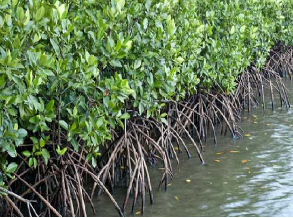
Akar Tunjang

Akar Papan
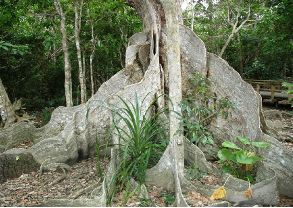
Akar Banir
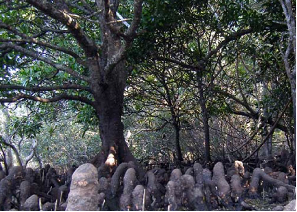
Akar Lutut
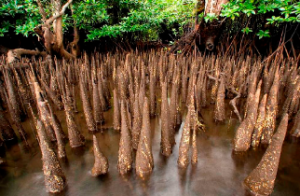
Akar Napas
Photo of mangrove forest roots. kkp.go.id
How Wide Are Mangroves in Indonesia?
Mangrove forests are widespread along the coastline of Indonesia. Mangrove forests in Indonesia are estimated to have an area of 4.2 million ha, which makes Indonesia the largest country that has mangrove forest land. Generally, mangroves can be found throughout the Indonesian archipelago. The largest mangrove land is in Irian Jaya with an area of around 2,951,476 hectares (69.43%), Sumatra 657,206 hectares (15.46%), and Kalimantan 383,441 hectares (9.02%) [2]. In its land and sea diversity, Indonesia is at the forefront of preserving mangrove ecosystems.
Why are Mangroves Important?
Mangroves provide invaluable ecosystem services, including supporting fisheries, providing protection against storms, and more. Worldwide, mangrove forests contribute approximately $1.6 billion annually to the local economy [3].
The dense root system of mangroves provides the perfect hiding place for small animals, and serves as a nursery habitat for many fish, shellfish, and crustaceans. Several commercially and recreationally important fish species depend on mangrove habitat for protection. Other animals that live directly on their roots, including snails, barnacles, and oysters.
Strong mangrove roots help prevent erosion by trapping sediment in their tangled roots. They also become very important during storms: their roots can help break down wave energy and reduce storm surge. According to recent reports, every 100 m (inland) mangrove forest can reduce wave height by up to 66% [4]. Finally, mangroves are an important part of the fight against climate change: worldwide, they can absorb or store more than 28 million tons of carbon each year. One hectare of mangrove forest alone can absorb 725 kg of carbon per year.
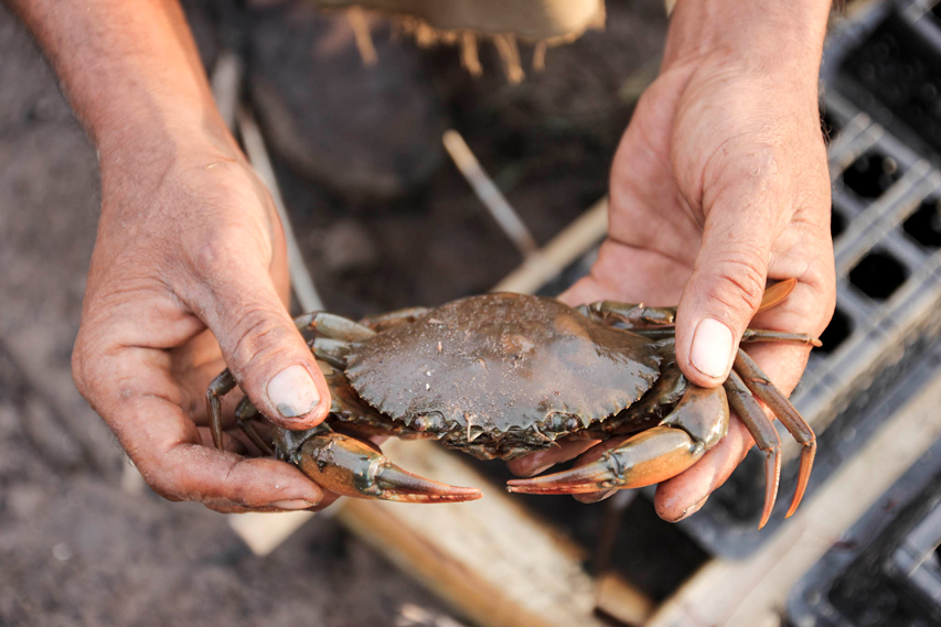
Photo of crab catches in mangroves. Koran.tempo.co
Why are mangroves problematic?
Mangrove forests love to live on tropical coastlines—and so do humans. Unfortunately, this means that many mangrove forests are being cut down and used as land for coastal development, sandy beaches, and aquaculture (in particular, shrimp farming has caused a large loss of mangrove forests). According to data from the FAO of the United Nations (2007) Since the 1980s, the area of global mangrove forests has decreased by 3.6 million ha [5]. When mangrove forests are cut down, they release large amounts of carbon dioxide into the atmosphere, thus contributing to climate change.
Fortunately, awareness of the importance of mangrove forests has spread and there are efforts around the world to restore mangrove habitat. You can help by supporting groups working to protect and restore mangrove habitat, and eating sustainably caught seafood. In addition, you can also join us in efforts to help protect Indonesia’s marine ecosystems, including mangrove habitats.
10 Facts About Mangrove Forests
Fact 1: Mangroves can taste slightly salty.— Unlike most trees, mangroves can grow directly in salt or brackish water.[6] Their strategies for dealing with toxic salinity levels vary. Some species excrete salt after it is absorbed, while other species filter salt from the surrounding sea water.[7]
Fact 2: Mangroves vary in size.— Although estimates vary, there are at least 50, and possibly as many as 80 species of mangroves, ranging from small shrubs to trees 40 meters above water, all species thrive in low-oxygen, high-salinity coastal environments.[8,9]
Fact 3: A place where fish congregate.— Mangroves, especially the underwater habitats provided by their roots, offer an important nurturing environment for many young marine species, from small gobies to large crocodiles.[10]
Fact 4: Mangroves can be found on saltwater coasts in more than 100 tropical and subtropical countries, with a total area of more than 140,000 square kilometers[11] — roughly the size of Greece or Arkansas.
Fact 5: Indonesia tops the world list.— The largest amount of mangrove cover is found in Indonesia, with a mangrove forest area of 31,000 km2[12] – about twice the size of Jamaica.
Fact 6: Mangrove forests have a (carbon) landfill problem.— Within an area of 2.6 km2 of mangrove forest, the mangrove forest ecosystem stores an amount of carbon equivalent to the annual emissions of 90,000 cars[13], making it an important solution in the fight against climate change.
Fact 7: Mangrove forests can help keep people safe.— Mangrove forests, especially their thick, impenetrable roots, are essential for communities living along the coast, as a natural buffer against storm surges[14], which pose an increasing threat to global climate change with rising sea levels.
Fact 8: Mangrove forests are under threat.— Almost all over the world, mangrove forests are threatened with extinction, but the most acute problem occurs in Myanmar, where a study estimates[15] the rate of mangrove forest loss in the country is more than five times the average rate of mangrove destruction globally.
Fact 9: Shrimp is a huge problem.— In Thailand, Mexico and Indonesia, mangrove forests are often cut down to make room for shrimp farms. But once the pond is abandoned, the accumulation of biowaste makes the water too toxic for most life.[8]
Fact 10: It is better to revitalize than to replant.— The dense root system of mangroves impedes the flow of tidal water and promotes the deposition of nutrient-rich sediments. But once mangrove forests are gone, it will be very difficult to replant due to the shift of sediment assisted by roots to remain in place.[16]
Reference
- (2021, July 26). My Mangrove, My Livelihood. https://www.iucn.org/news/oceania/202107/my-mangroves-my-livelihood
- (2017). The Role of Mangrove Forest Ecosystems as Habitats for Marine Organisms. Journal of Tropical Biology. 17(2) : 51-58. https://media.neliti.com/media/publications/273833-peran-ekosistem-hutan-mangrove-sebagai-h-a0aa7758.pdf
- Spencer, E. (2019, November 13). Everything You Need to Know About Mangroves. Mangroves have a Big Role in Keeping Our Ocean and Coastlines Healty. Ocean Conservancy. https://oceanconservancy.org/blog/2019/11/13/everything-need-know-mangroves/
- Hardianti, P. F. (2014). Analysis of the Ability of Mangrove Forests to Dampen Waves on Kenjeran Beach Surabaya [Final Project]. Surabaya [ID] : Sepuluh Nopember Institute of Technology. https://repository.its.ac.id/65319/1/4309100045-UndergraduateThesis.pdf
- FAO of United Nations. (2007). The World’s Mangroves 1980-2005. In A Thematic Study Prepared in The Framework of The Global Forest Resources Assessment 2005. Rome : FAO. https://www.fao.org/3/a1427e/a1427e00.pdf
- Somma, Marina. Trees That Grow in Saltwater sciencing.com, https://sciencing.com/trees-that-grow-in-saltwater-13429031.html. September 21, 2022.
- Lim, K., Murphy, D., Morgany, T., Sivasothi, N., Ng, P., Soong, B. C., Tan, H., Tan, K. S., Tan, T. K., (2001). A Guide to Mangroves of Singapore. Raffles Museum of Biodiversity Research, The National University of Singapore &; The Singapore Science Centre. http://mangrove.nus.edu.sg/guidebooks/text/1042.htm
- Feller, C. (ed.). Smithsonian. (2018, April). Mangroves. https://ocean.si.edu/ocean-life/plants-algae/mangroves
- (2021, March 25). What is a mangrove forest? National Ocean Service website. https://oceanservice.noaa.gov/facts/mangroves.html
- Florida Museum. (2020, November 27). Mangrove Life. https://www.floridamuseum.ufl.edu/southflorida/habitats/mangroves/mangrove-life/
- 2020. Global Forest Resources Assessment 2020: Main report. Rome. https://www.fao.org/documents/card/en/c/ca9825en
- Beys-da-Silva, W. O., Santi, L., &; Guimarães, J. A. (2014). Mangroves: A Threatened Ecosystem Under-Utilized as a Resource for Scientific Research. In Journal of Sustainable Development (Vol. 7, Issue 5). Canadian Center of Science and Education. https://doi.org/10.5539/jsd.v7n5p40
- (2022, June 8). Coastal Blue Carbon. National Ocean Service website. https://oceanservice.noaa.gov/ecosystems/coastal-blue-carbon/
- Blankespoor, B., Dasgupta, S., &; Lange, G.-M. (2016). Mangroves as a protection from storm surges in a changing climate. In Ambio (Vol. 46, Issue 4, pp. 478–491). Springer Science and Business Media LLC. https://doi.org/10.1007/s13280-016-0838-x
- Richards, D. R., &; Friess, D. A. (2015). Rates and drivers of mangrove deforestation in Southeast Asia, 2000–2012. In Proceedings of the National Academy of Sciences (Vol. 113, Issue 2, pp. 344–349). Proceedings of the National Academy of Sciences. https://doi.org/10.1073/pnas.1510272113
- Waters, H. Smithsonian. (2016, December). Mangrove Restoration: Letting Mother Nature Do The Work. https://ocean.si.edu/ocean-life/plants-algae/mangrove-restoration-letting-mother-nature-do-work
Writer: Aisha Nabila Fahsa

